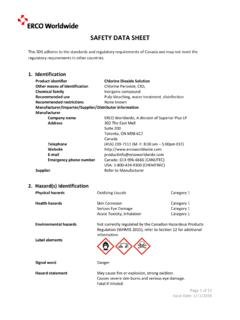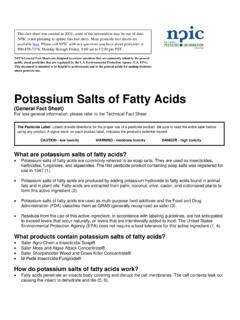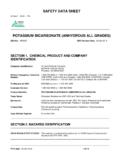Transcription of POTASSIUM HYDROXIDE SOLUTION WHMIS …
1 Page 1 POTASSIUM HYDROXIDE SOLUTIONWHMIS CONTROLLED PRODUCTDate Issued:08/16/2012 Revision #:6 MATERIAL SAFETY DATA SHEET 1. Chemical Product And Company InformationChemical Name: POTASSIUM HYDROXIDE SolutionSynonyms/Trade Names: Caustic Potash SOLUTION , KOH, Potash Lye, Lye, Lye SolutionChemical Family: Alkali metal hydroxideFormula: KOHM olecular Weight : No.: 1310-58-3 Uses: Saponification of fats, manufacture of biodiesel, electrolytee for batteries, manufacture of soft soaps, manufacture of fine chemicals, manufacture of fertilizers and other agricultural & Supplier:Transportation Emergency Telephone Numbers :ERCO Worldwide, a division of Superior Plus LP302 The East Mall, Ste. 200 Toronto, Ontario Canada M9B 6C7(416) 239-7111 ERCO Worldwide (USA) Highway 73 SouthNekoosa, Wisconsin 54457(715) 887-4000 USA:1-800-424-9300 CHEMTRECCANADA: (613) 996-6666 CANUTECE mergency Information:Call toll-free 24 hours a day: 866-855-6947 Canadian WHMIS Classification (s):E - Corrosive D1B- Toxic 2.
2 Composition / Information On Ingredients Name: Conc. % By Weight CAS Hydroxide50% or less1310-58-3 Page 2 3. Hazard IdentificationEmergency Overview :White to light grey, odorless, viscous liquidDANGER Corrosive. Causes severe burns to skin, eyes and digestive tract. Harmful if swallowed or inhaled. Routes of Entry :INHALATIONB reathing of mist is possible. Breathing this material is harmful and can cause death. Harmful effects include burns and permanent damage to the airways, including the nose, throat and lungs. SKINC auses skin burns and permanent skin burns and permanent injury to eye tissue. Can cause blindness. INGESTIONS wallowing this material may be harmful or cause death. Harmful effects include burns and permanent damage to the digestive tract, including the mouth, throat, stomach and intestines. Symptoms may include severe abdominal pain and vomiting of blood.
3 Blood loss through damaged tissue can lead to low blood pressure and shock. Symptoms of Exposure :Depending upon level and duration of exposure, other possible signs and symptoms from breathing, swallowing, and contact of this material with the skin may include: irritation of the nose, throat, airways, and lungs with cough, sneezing, perforation of the nasal septum, and blindness. MEDICAL CONDITIONS AGGRAVATED BY EXPOSUREP reexisting disorders of the following organs or systems which may be aggravated by exposure to this material (or a component) include: respiratory system (includining asthma and other breathing disorders), and eyes. EFFECTS FOLLOWING REPEATED EXPOSUREThis material may cause the following effects: eye damage, blindness, respiratory tract damage (nose, throat, airways) lung damage, skin damage, and gastrointestinal tract damage. Page 3 4. First Aid MeasuresSkin:Immediately wash exposed skin with plenty of soap and water while removing contaminated clothing and shoes.
4 Wash for at least 15 to 20 minutes. Get immediate medical attention. Wash clothing before reuse and throw away shoes which cannot be thoroughly :Hold the eyelids apart and flush the eye gently with a large amount of water for at least 15 to 20 minutes. Get immediate medical attention. Washing eyes within several seconds of contact is necessaryInhalation:Remove individual to fresh air and get immediate medical attention. If breathing is difficult, give oxygen. If breathing stops, give artificial respiration. Ingestion:Have a conscious person drink a glass of water or milk immediately if able to swallow. Get medical attention immediately. Do not induce vomiting unless directed to do so by medical personnel. Never give anything by mouth to an unconscious TO PHYSICIANP robable mucosal damage may contraindicate the use of gastric lavage. Page 4 5. Fire-Fighting MeasuresConditions Of Flammability :Not combustible, however the product can react with metals such as aluminum, tin, zinc to form flammable and explosive hydrogen gas ( see Reactivity Section 10 )Means To Extinguish : POTASSIUM HYDROXIDE does not burn or support combustion.
5 Use extinguishing agents compatible with POTASSIUM HYDROXIDE and appropriate for the surrounding fire. If water is used, care should be taken, since it can generate heat and cause spattering if applied directly to POTASSIUM NOT use carbon dioxide as an extinguishing FIGHTING INSTRUCTIONSE vacuate area and fight fire from a safe distance or a protected location. Approach fire from upwind to avoid toxic decomposition must be used with extreme caution to extinguish a fire in an area where POTASSIUM HYDROXIDE is stored and must not come into contact with the POTASSIUM HYDROXIDE does not burn and does not support combustion. However, closed containers may rupture violently when exposed to the heat of the fire. If possible, isolate materials not yet involved in the fire and move containers from the fire area if this can be done without risk and they have not been exposed to heat.
6 Use extreme caution since decomposition may occur under fire conditions and heat may rupture containers. If it is not possible to move containers, apply water in flooding quantities from the side and from a safe distance, to keep fire-exposed containers, tanks or car/trailer loads cool and absorb heat to help prevent rupture, and protect personnel. If necessary, use unmanned monitors and hoseholders to keep cooling streams of water on fire-exposed tanks or containers until well after the fire is out. Water spray may also be used to knock down corrosive and toxic fumes and vapours which may be produced in a fire. Fire control or dilution water may be corrosive and/or toxic. Dike fire control water for appropriate immediately in case of rising sound from venting safety device or any discolouration of tank. ALWAYS stay away from the ends of tanks, but be aware that flying material (shrapnel) from ruptured tanks may travel in any direction.
7 Tanks or drums should not be approached directly after they have been involved in a fire, until they have been completely cooled of Fire Fighters : POTASSIUM HYDROXIDE solid and solutions are very corrosive and at high temperatures decomposition occurs giving off strong, corrosive fumes of POTASSIUM oxide. Do not enter without wearing specialized equipment suitable for the situation. Firefighter's normal protective clothing (Bunker Gear) will not provide adequate protection. Chemical protective clothing ( chemical splash suit) and positive pressure self-contained breathing apparatus (NIOSH approved or equivalent) may be Combustion Products :NoneFlash Point & Method: Not applicableUpper Flammability Limit : Not applicableLower Flammability Limit : Not applicableAuto-Ignition Temperature : Not applicableMechanical Impact Sensitivity : Not sensitiveStatic Discharge Sensitivity : Not applicable Page 5 6.
8 Accidental Release MeasuresLeak Or Spill Procedures :Cleanup personnel must wear proper protective equipment (refer to Section 8). Completely contain spilled material with dikes, sandbags, etc., and prevent run-off into ground or surface waters or sewers. Recover as much material as possible into containers for disposal. Remaining material may be neutralized with dilute hydrochloric or acetic acid. Neutralization products, both liquid and solid, must be recovered for disposal. Reportable Quantity (RQ) is 1000 lbs. Notify National Response Center (1-(800)-424-8802) of uncontained releases to the environment in excess of the RQ. Waste Control Procedures :All disposals of this material must be done in accordance with Federal, state and local regulations. Waste characterization and compliance with disposal regulations are the responsibilities of the waste RESIDUESR ecovered solids or liquids may be sent to a licensed reclaimer or disposed of in a permitted waste management facility.
9 Consult Federal, state, or local disposal authorities for approved procedures. Do not dump into any sewers, on the ground, or into any body of water. 7. Handling StorageHandling Procedures And Equipment :Do not get in eyes, on skin or on clothing. Avoid breathing mist. Do not taste or swallow. Do not eat, drink, or smoke in work area. Wash hands prior to eating, drinking, or using restroom. Any protective clothing or shoes which become contaminated with caustic potash should be removed immediately and thoroughly laundered before any reuse. Follow protective controls set forth in Section 8 when handling this product. When diluting with water, slowly add caustic potash SOLUTION to cold water with mixing. Heat will be produced during dilution. Full protective clothing, goggles and faceshield should be worn. Do not add large quantities of water to caustic potash because excessive heat formation will cause boiling and :Store in closed, properly labeled tanks or containers.
10 Do not remove or deface labels or tags. Contact of caustic potash cleaning solutions with food and beverage products (in enclosed vessels or spaces) can produce lethal concentrations of carbon monoxide gas. Do not enter confined spaces such as tanks or pits without following proper entry procedures as required by OSHA 29 CFR or other local regulatory MATERIALS FOR STORAGE OR TRANSPORTA luminum equipment should not be used for storage and/or transfer. Page 6 8. Exposures Controls / Personal ProtectionProtective Equipment :EYE AND FACE PROTECTIONWear chemical goggles. A face shield should be worn in addition to goggles where splashing or spraying is possible. A full face respirator,In place of goggles and a face shield, will also provide excellent face protection. SKIN PROTECTIONWear chemical resistant clothing, boots, and gloves, which are made of neoprene, PVC, or rubber.











